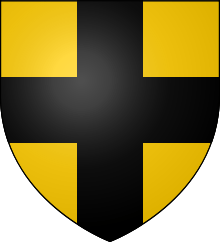William de Vescy of Kildare
| William de Vescy of Kildare | |
|---|---|
 Coat of arms of William de Vescy, after succeeding his father. | |
| Noble family | de Vesci |
| Father | William de Vesci |
| Born | bef. 1297 |
| Died |
24 June 1314 Bannockburn |
- For other persons named William de Vescy, or William de Vesci, see William de Vesci.
William de Vescy, sometimes spelt Vesci (d 24 June 1314 Bannockburn), was an illegitimate child of William de Vesci and Devorgille, daughter of Donal Roe Macarthy Mor, Prince of Desmond. He was born in Kildare, Ireland, and after his father died in 1297, as he was underage, his properties in England were in trust under Antony Bek, Bishop of Durham.
In 1300, William was summoned to serve in an army against the Scots.
He or his guardian Antony Bek, Prince Bishop of Durham, sold Alnwick Castle on 19 November 1309 to Henry de Percy, 1st Baron Percy. (For more details, see the entry on Lord Percy). It is unclear how much of the money William actually received.
On 24 June 1314, while serving as a retainer of Aymer de Valence, Earl of Pembroke, William perished at the Battle of Bannockburn.[1]
Marriage and legacy
Although it is sometimes said that William married Maud, widow of Thomas Neville of Cleatham, this is unlikely.[1] On William's death, his estates devolved upon his distant cousin in law, Gilbert de Ayton, husband of Margery, daughter of Warin de Vesci, a son of Eustace de Vesci.
Arms
William's coat of arms is emblazoned: Or, a cross Sable. His arms are recorded in the Parliamentary Rolls. The arms had previously been borne by his father, and also his uncle, John de Vesci (d. 1289).[2]
References
- 1 2 Waugh, Scott L. (2004), "Vescy, William de, Lord Vescy (1245–1297)", Oxford Dictionary of National Biography ((subscription or UK public library membership required)) (online October 2005 ed.), doi:10.1093/ref:odnb/28256, retrieved 16 March 2012.
- ↑ McAndrew, Bruce A. (2006), Scotland's historic heraldry, Boydell Press, p. 74, ISBN 9781843832614.
 This article incorporates text from a publication now in the public domain: "Vescy, William de". Dictionary of National Biography. London: Smith, Elder & Co. 1885–1900.
This article incorporates text from a publication now in the public domain: "Vescy, William de". Dictionary of National Biography. London: Smith, Elder & Co. 1885–1900.